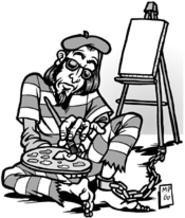"When you're in an art school, you have this automatic art community to bounce ideas off of," explains Nancy Prudic, co-director of the gallery. "But when you graduate, suddenly that disappears, and you have to reacclimate all of your work in a very solitary kind of approach. So people like this, because here it is again -- art school for 48 hours."
The annual event started off as just Eight Hours of Making Art, but the participants -- from all walks, including painters, performance artists, writers, photographers, and printmakers -- found themselves a tad crunched for time. PBS's Bob Ross may have been able to whip up a happy little painting in a half-hour, but the elusive expressions of experimental artists take a bit longer. So the function was expanded to two days and became 16 Hours of Making Art.
"After a couple of years of that, there were some artists who didn't want to go home in between, so they brought their camping stuff and slept over," Prudic recalls. "So we decided, why not just make it 48 Hours of Making Art?" The event proves that good ideas don't simply sprout, evolve, and achieve fruition in one day.
And though the artists -- 21 in all this year, all different from previous years -- now have a full weekend of interaction for themselves, Prudic stresses that the other goal of the program has not been forgotten. "The original intent was for the public to be there and participate and interact -- some artists actually plan for the public to work on their pieces. It's a very energetic, cooperative kind of environment. Public interaction is a vital part of the project."
Which is great for the Joe Fivethumbs of the world, who aspire to paint but can't render a stick figure accurately, but what about those stereotypical testy art types having to put up with comments and advice from the public? "Artists are very sensitive, and they respond very positively," Prudic assures us. "We've never had any conflict whatsoever. I have never heard anyone say, 'I hate what I did. I don't want this up. I feel really stupid.' Mostly they are really excited, because it gives them a lot of freedom, and they're grateful for that."
Happy accidents and all.


